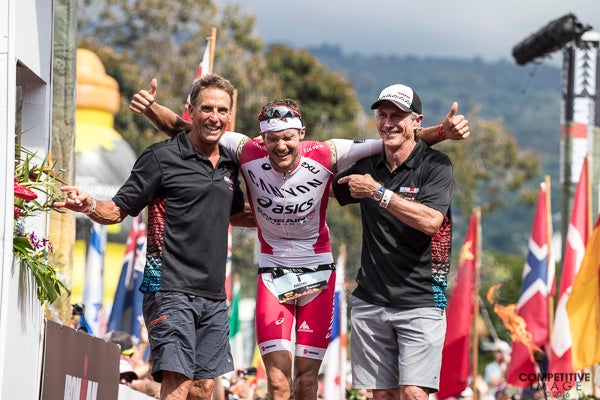This is How Ironman Legend Dave Scott Thinks Kona 2017 Will Go Down

Ironman legends Dave Scott and Mark Allen greeted Jan Frodeno at the finish line at the 2016 race. Photo: Paul Phillips/Competitive Image
Dave Scott earned his nickname “The Man” for his balls out training regimen and equally intense performances. He was the first person to win the Ironman World Championship six times, and the first person inducted into the Ironman Hall of Fame. The 63-year old is the master of the Kona course, and out of interest both personal and professional—he’s also a coach—he’s kept up his studies, noting how the tactics necessary to win have changed since his days of domination. Here, he shares in his own words the very different strategies he believes the men and women must make to take home the crown.
RELATED: Ironman Legend Dave Scott Shares His Nutrition Tips
The differences start with the swim.
The swim dynamic is different with the men than with the women. A lot of the men are good swimmers and typically good cyclists as well, but a lot of the women are often playing catch-up off the swim and bike.
The women can race at a more even pace.
The women’s race isn’t more predictable, but a lot of the women know what they’re dealt before the gun goes off a little bit more than the men. Having more predictability generally allows them to ride at an even, steady state. For the women down two to five minutes on the swim, my response is: “So what? Lock in on what you’re capable of doing.”
The men must pay attention to bike surges.
The men’s race is not like that. There’s this reactionary output—someone is accelerating on the bike, and the legal-drafting group of 18 to 20 guys responds to that. The best strategy is not to sit back at, say, number 13, but try to be in the top three.
Guys that are not the greatest runners, but they’re stronger on the bike—they should take off and physically punish the better runners, take some of the energy out of their legs so there’s a little more unknown when they get off the bike.
If I was in the race now, and I was strong on the swim and the bike, I’d say, “I’m gonna go. I’m going to dictate the race and let everyone else follow my lead.” I’d like the athletes to do that a little bit more, to say, “I’m a player in this, I’m not just a follower.”
When I won the race, the bike was a steady-state level of discomfort—it didn’t have these really high peaks up and down. The athletes now have to train that high-end so they don’t feel shattered when they get off the bike.
The point of attrition on the bike is in Kawaihae.
There’s a town on the way back from Hawi called Kawaihae. It’s a port city, it’s real hot. There’s about a mile and a quarter between 7 and 9 percent grade. The air’s real stagnant. You’re back on the Queen K and you see this sign that says: Kailua, 32 miles. You see the men fall off between that point and the next six or seven miles. It happens every year.
Everyone needs to believe in themselves more.
I don’t know how many of the athletes, both male and female, truly believe they can win. A lot of people count themselves out. No one’s 100 percent, but the mental tenacity that people should have is: “I haven’t won one of these, but I feel I can win.”
Neither gender has nabbed their best run time yet
Then you won’t get these massive increases in power output. These little surges of very high wattage take the punch out of their legs. Neither gender—and I’m not saying this harshly—they haven’t run to their potential. The women are trying to catch the leaders—are they over extending themselves on the bike? I don’t know. We should see a handful going 2:55 on the run. [Switzerland’s Daniela Ryf ran a 2:56:51 in 2016 on her way to a new overall course record. Australia’s Miranda Carfrae owns the run course record, a 2:50:38 set in 2013.] I think Kienle and Frodeno are both capable of running 2:36 or 2:37. [Germany’s Patrick Lange set the men’s run course record in 2016 at 2:39:45.]
On that day, at the world championship, you don’t want to leave anything out on the course. But you have to be savvy and cognizant of the competition.
Some men who crushed the bike tend to falter early on the run.
I typically stay not quite three miles into the run. A lot of the men are decimated from the surges by the time the put their running shoes on and they have no run legs at all. You rarely see someone back on the run who picks it up. I’d like to see people come out of the gate on the run and say, “I can still win this. I’m going to go out at my pace.” But that doesn’t happen.
…while women you didn’t pay attention to on the bike pick it up on the run.
Women move up that no one’s even talking about on the bike and all the sudden they’re in the game.